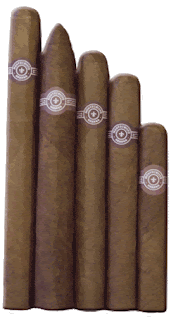
Nobody knows for sure when the tobacco plant was first cultivated, but there is little doubt about where. The native people of the American continent were undoubtedly the first not only to grow, but to smoke the plant, which probably first came from the Yucatan peninsula, Mexico. It was certainly used by the Maya of Central America, and when the Maya civilization was broken up, the scattered tribes carried tobacco both southward into South America, and to North America, where it was probably first used in the rites of the Mississipi Indians. It didn't come to the attention of the rest of the world until Cristopher Columbus's momentous voyage of 1492.
Columbus himself was not particularly impressed by the custom, but soon Spanish and other European sailors fell for the habit, follwed by the conquistadores and colonist. In due course the returning conquistadores introduced tobacco smoking to Spain and Portugal. The habit, a sign of wealth, then spread to France, through the French ambassador to Portugal, Jean Nicot (who eventually gave his name to nicotine, and Nicotiana tabacum, the Latin name for tobacco).

The word tobacco, some say, was a corruption of Tobago, the name of a Carribbean island. Others claim it comes from the Tabasco province of Mexico. Cohiba, a word used by the Taino Indians of Cuba was thought to mean tobacco, but now is considered to have reffered to cigars. The word cigar originated from sikar, the Mayan word for smoking.
Although the first tobacco plantation were set up in Virginia in 1612, and Maryland in 1631, tobacco was smoked only in pipes in the American colonies. The cigar itself is thought not to have arrived until after 1762, when Israel Putnam, an American general in the Revolutionary War, returned from cuba, where he had been an officer in the British army. He came back to his home in Connecticut with a selection of Havana cigars, and large amounts of Cuban tobacco. Before long, cigar factories were set up in the Hartford area. Production of the leaves started in the 1820s, and Connecticut tobacco today provides among the best wrapper leaves to be found outside Cuba. By the early 19th century, not only were Cuban cigars being imported into the United States, but domestic production was also taking off.
The habit of smoking cigars spread out to the rest of Europe from Spain, where cigars using Cuban tobacco were made in Seville from 1717 onwards. By 1790 cigar manufacture had spread north of the Pyreness, with small factories being setup in France and Germany. But cigar smoking didn't really takeoff in France and Britain until after the Penninsula War (1806-12) against Napoleon, when returning British and French veterans spread the habit they had learned while serving in Spain. By this time the pipe had been replaced by snuff as the main way of taking tobacco, and cigars now became the fashionable way of smoking it. Production of segars, as they were known, began in Britain in 1820.
Soon there was a demand of higher quality cigars in Europe, and the Sevillas, as spanish cigars were called, were superseded by those from cuba (then a spanish colony), not least as the result of a decree by King Ferdinand VII of Spain in 1821. Cigar smoking became such a widespread custom in Britain and France that smoking cars became a feature of European trains, and the smoking room was introduced in clubs and hotels. The habit even influenced clothing--with the introduction of the smoking jacket. In France, tuxedos are still referred to as le smoking.
It is widely believed that Christopher Columbus' crew discovered cigars while exploring Cuba. The Cuban natives smoked a crude form of the modern day cigar during religious ceremonies. The cigar was wrapped with maize and filled with tobacco leaves. Columbus' crew quickly became accustomed to smoking the cigar and brought back samples of the "Golden Leaf" to Spain. Initially, the smoking of cigars was considered a pagan ritual punished by imprisonment. In fact, one of Columbus' crew members was imprisoned for smoking. However, after a few years, cigar smoking became widely accepted. Eventually, Spain would build an entire industry around the cigar. Seville, Spain was at the center of this and is recognized as being the birthplace of the modern cigar.
At first, Spain imported the raw materials from Cuba and assembled the cigars themselves. However, in 1821 Spain allowed Cuba to manufacture Cigars and hence the Cuban cigar was born. In appreciation for Spain's kind gesture, the Cubans would deliver a box of their best cigars to the Spanish king every year. These cigars were the fabled Trinidad's.
Cigars become popular in the United States during the Lincoln years. Factories began to open in New York, Connecticut and Pennsylvania. The term stogie is actually named after Conestoga, Pennsylvania where one of the first cigar factories were built.
The cigar industry did well up until the 1960's when smoking became more of a health concern amongst Americans. At the same time, the United States imposed an embargo against Cuba making it illegal for US citizens to import goods from Cuba. Today Cigars are back and are becoming extremely popular amongst men and women.


No comments:
Post a Comment